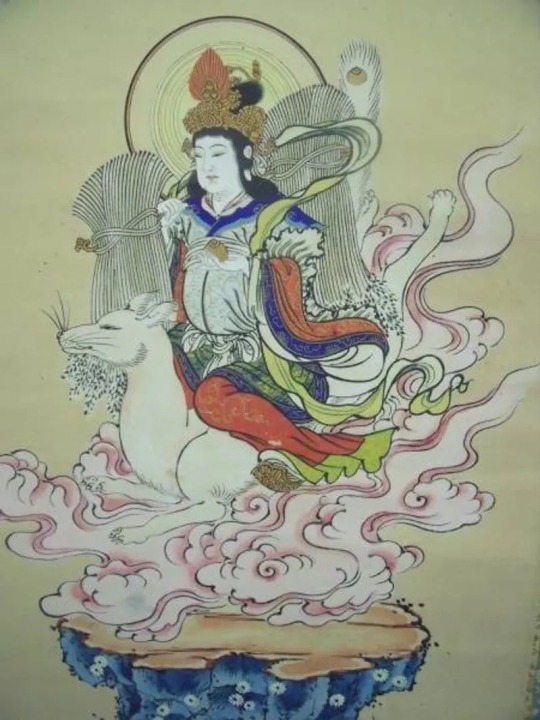#Shugojin
Explore tagged Tumblr posts
Text
Saijō-i Kyō-ō Dai-zenjin (Inari)
The deity Saijō-i Kyō-ō Dai-zenjin is commonly referred to as “O-Inari-san”, and is sometimes believed to have the form or appearance of a fox, however this is a misunderstanding. The Eternal Buddha, who is without form, appears for the sake of all sentient beings in the form of this bodhisattva who is a protector deity of the Lotus Sūtra.
“Saijō-i”, which means “highest ranked” indicates that this deity is ranked highest among all gods. “Kyō-ō” which means “Sūtra King” shows that among all the many Buddhist sūtras, the hidden truth that Śākyamuni Buddha is the Eternal Buddha, our Original Teacher, is only expounded in the Lotus Sūtra, or Myōhō Renge Kyō. “Dai-zenjin” means “great benevolent deity”.
In other words, Saijō-i Kyō-ō Dai-zenjin is a manifestation of the wonderful power, which is beyond human understanding, contained in the Lotus Sūtra which we receive and uphold.
Saijō-i Kyō-ō Dai-zenjin’s appearance is usually that of a beautiful woman with a bundle of rice on her left shoulder holding a sickle in her right hand, accompanied by a white fox holding a wish-fulfilling gem (Cintāmaṇi) in its mouth.
The bundle of rice symbolises the fact that the Venerable Saijō-i is a deity of the five grains, meaning she protects our lives with food. The sickle, taken together with the rice bundle, is a widely used set representing farming, and taking care of and dispersing evil. The wish-fulfilling gem in the fox’s mouth signifies the fulfilment of wishes and good luck. That Saijō-i Kyō-ō Dai-zenjin travels or rides on a white fox symbolises her purity, and white is also symbolic of her mysterious spiritual ability to appear and disappear like a phantom.
The misconception that Inari is a fox seems to be so widespread perhaps due to a common fear of the spiritual power of foxes in Japan.
As a deity representing the wisdom of the Lotus Sūtra, Inari is invoked in many Nichiren Shu temples. Especially famous are the Fushimi, Yūtoku and Toyokawa Inari shrines which are known as the “Three Great Inari of Japan”, as well as the Nichiren Shu temple called “Saijō Inari-san Myokyoji” in Okayama Prefecture.
You can find Inari-san enshrined in many people’s homes, along with Daikokuten, the god of happiness, wealth and longevity, and the water deities “Hachi Dai-ryū-ō” (the Eight Great Dragon Kings).
In: https://nichiren-shu.org.uk/shugojin-1

20 notes
·
View notes
Photo

Claw-like hand of a cast iron guardian deity (守護神/shugojin) holding a persimmon. Sitting next to Ozenji Temple and right across from Japan's oldest existing sweet persimmon tree, my guess is that his job is to scare demons away from not only the temple, but protect the persimmon tree as well. ISO 500 at ƒ/7.1 for 1/125 sec. #OzenjiTemple #BuddhistTemple #GuardianDiety #persimmon #柿 #王禅寺 #星宿山王禅寺 #守護神 #PentaxKP
13 notes
·
View notes
Text
Japanese Word of the Day
#Japanese #WordoftheDay 守護神 (しゅごじん/shugojin) 'guardian deity' Example: 「守護神」の視界を明に
— Learning Japanese (@LearnJPBOD) February 24, 2020
19 notes
·
View notes
Photo

A cast iron "guardian deity" (守護神/shugojin) next to Ozenji Temple in Kawasaki looking towards Japan's oldest existing sweet persimmon tree (over 450 years old), which is planted nearby. ISO 800 at ƒ/5.6 for 1/100 sec. #OzenjiTemple #BuddhistTemple #GuardianDeity #王禅寺 #星宿山王禅寺 #守護神 #PentaxKP
9 notes
·
View notes
Text
#Japanese #WordoftheDay 守護神 (しゅごじん/shugojin) 'guardian deity' Example: 「守護神」の視界を明に
— Learning Japanese (@LearnJPBOD) August 6, 2017
27 notes
·
View notes
Text
#Japanese #WordoftheDay 守護神 (しゅごじん/shugojin) 'guardian deity' Example: 「守護神」の視界を明に
— Learning Japanese (@LearnJPBOD) February 25, 2017
19 notes
·
View notes